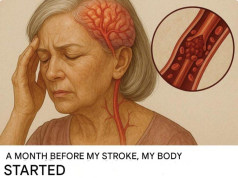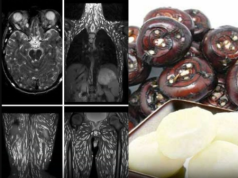Turning 40 is more than just a milestone birthday — it’s often a wake-up call.
Energy slows. Metabolism shifts. And for the first time, many start thinking seriously about long-term health.
Among the most critical concerns?
👉 Brain and heart health.
One condition that often flies under the radar — but can be a life-saving warning — is the mini stroke, medically known as a transient ischemic attack (TIA).
While it doesn’t cause permanent brain damage, a TIA is not “just a scare.”
It’s a major red flag that a full-blown stroke could be just around the corner.
And for people over 40, the risk rises sharply — especially if lifestyle or health conditions go unchecked.
Let’s break down what a mini stroke is, why it’s so dangerous, and what you can do to protect yourself.
🧠 What Is a Mini Stroke (TIA)?
A transient ischemic attack (TIA) is a temporary blockage of blood flow to the brain, usually caused by:
- A small blood clot
- Narrowed or damaged arteries
- Plaque buildup (atherosclerosis)
The symptoms mimic those of a full stroke — but they resolve within minutes to a few hours, and no permanent brain damage occurs.
But don’t let the “temporary” part fool you.
A TIA is your brain’s way of saying:
“I came close. Next time, I might not make it.”
⚠️ Why a TIA Is a Medical Emergency
Even though symptoms go away, a TIA is a medical emergency.
- 1 in 3 people who experience a TIA will go on to have a full stroke — and half of those happen within 48 hours to 3 months.
- A stroke can lead to paralysis, speech loss, memory damage, or death.
Think of a TIA as a warning system — the brain’s version of a fire alarm.
Ignoring it could be deadly.
🔍 Common Symptoms of a Mini Stroke
TIA symptoms appear suddenly and may last just a few minutes — but they should never be ignored.
Use the F.A.S.T. acronym to recognize them:
| F | Face drooping | One side of the face may droop or feel numb | | A | Arm weakness | Can’t raise one arm, or it drifts downward | | S | Speech difficulty | Slurred speech, trouble speaking or understanding | | T | Time to call 911 | Even if symptoms disappear — call immediately |
✅ Other possible signs:
- Sudden confusion or trouble thinking
- Vision problems in one or both eyes
- Dizziness, loss of balance, or coordination
- Severe headache with no known cause
💡 Key difference: TIA symptoms resolve completely within 24 hours (often in under an hour).
But you can’t tell a TIA apart from a stroke without medical imaging — so always seek emergency care.
🚩 Why People Over 40 Are at Greater Risk
After 40, natural aging combines with lifestyle habits to increase the risk of vascular issues.
Key risk factors for TIA and stroke:
- High blood pressure – The #1 risk factor; often silent and undiagnosed
- High cholesterol – Leads to plaque buildup in arteries
- Diabetes or prediabetes – Damages blood vessels and increases clotting risk
- Smoking – Damages blood vessels and raises blood pressure
- Obesity and sedentary lifestyle – Contribute to heart disease and poor circulation
- Family history of stroke or heart disease
- Atrial fibrillation (AFib) – An irregular heartbeat that can cause clots
Even if you feel fine, these conditions can be “silent killers” — doing damage long before symptoms appear.
🛡️ How to Reduce Your Risk After 40
The good news?
Up to 80% of strokes are preventable.
Here’s how to protect your brain and heart:
✅ 1. Monitor Your Numbers
- Check blood pressure regularly (ideal: below 120/80)
- Get cholesterol and blood sugar tested annually
- Know your BMI and waist circumference
✅ 2. Eat a Heart-Healthy Diet
- Focus on:
- Vegetables, fruits, whole grains
- Lean proteins (fish, poultry, legumes)
- Healthy fats (avocados, nuts, olive oil)
- Limit:
- Salt, sugar, processed foods, red meat
✅ 3. Stay Active
- Aim for 150 minutes of moderate exercise per week (walking, cycling, swimming)
- Even 10-minute walks add up
✅ 4. Quit Smoking
- Smoking doubles your stroke risk — quitting reverses damage over time
✅ 5. Limit Alcohol
- No more than 1 drink per day (women) or 2 (men)
✅ 6. Manage Chronic Conditions
- Keep diabetes, high blood pressure, and AFib under control with medication and lifestyle changes
✅ 7. Get Regular Check-Ups
- See your doctor yearly — especially if you have risk factors
🏥 What Happens After a TIA?
If you experience a mini stroke, doctors will act fast:
- Brain imaging (CT or MRI) to rule out a full stroke
- Carotid ultrasound to check for artery blockages
- Heart monitoring to detect AFib
- Blood tests for cholesterol, blood sugar, and clotting factors
You may be prescribed:
- Blood thinners (like aspirin or clopidogrel)
- Medications to lower blood pressure or cholesterol
- Lifestyle changes — often with a follow-up plan within days
This is not “over.”
It’s the beginning of stroke prevention.
💡 Final Thoughts: A Wake-Up Call, Not a Death Sentence
A mini stroke isn’t a minor event — it’s a critical warning.
But it’s also a gift:
👉 The chance to make changes before permanent damage occurs.
If you’re over 40, don’t wait for symptoms.
Start protecting your brain today.
Check your numbers.
Move your body.
Eat well.
Listen to your body.
Because when it comes to stroke, the best time to act was yesterday —
The second-best time?
👉 Right now.
Your brain is counting on you. Don’t ignore the warning.










